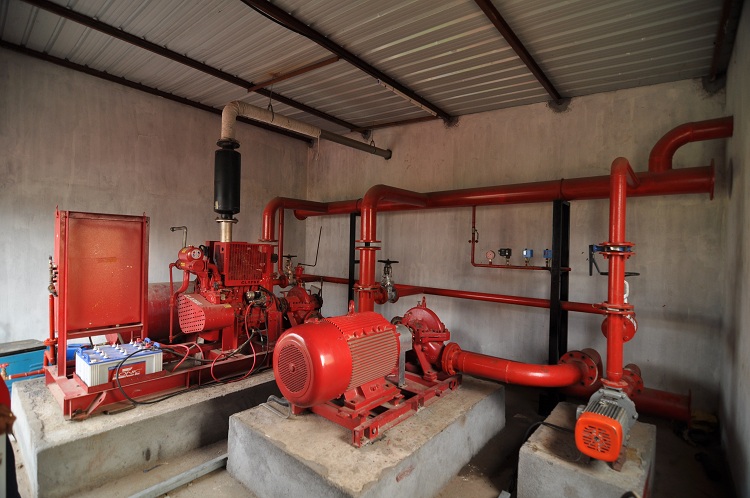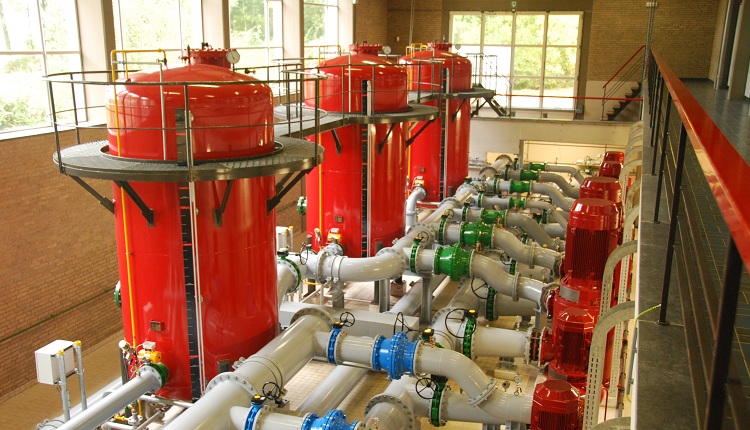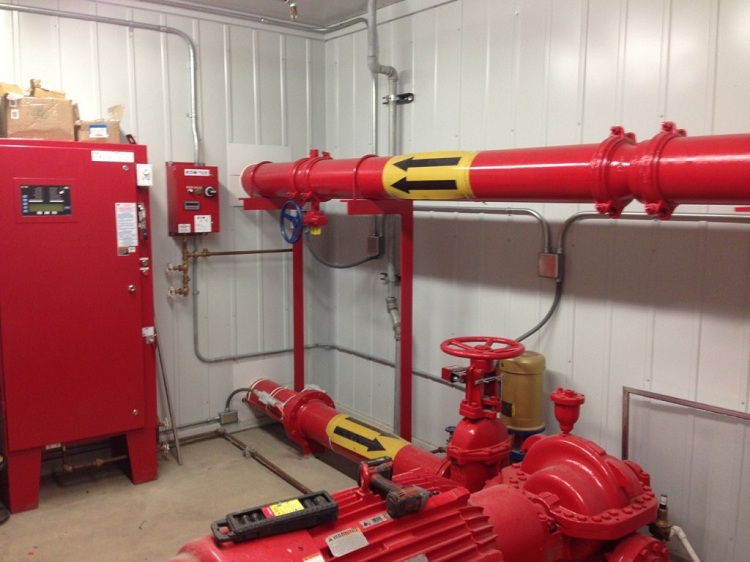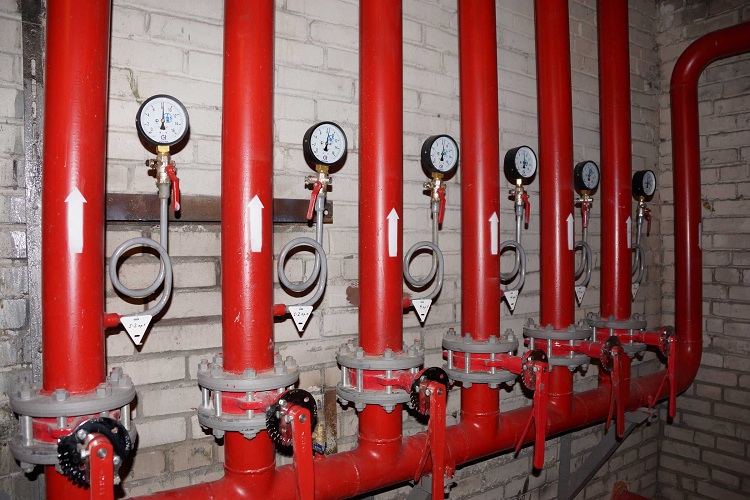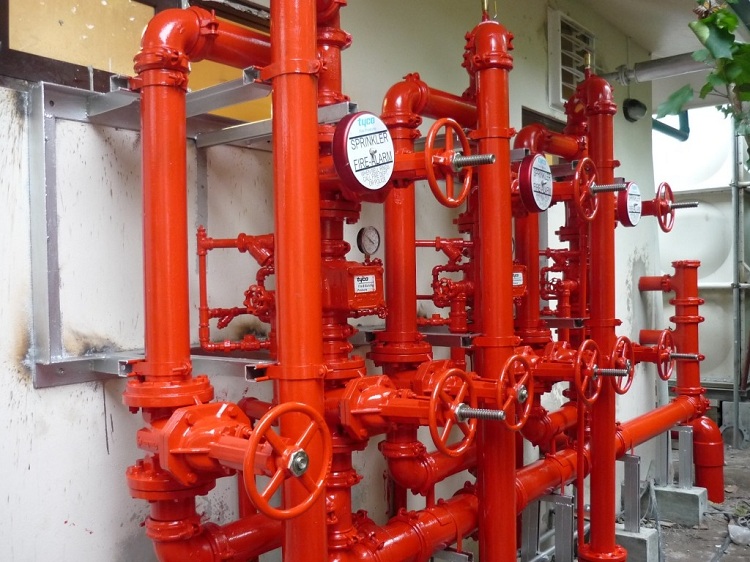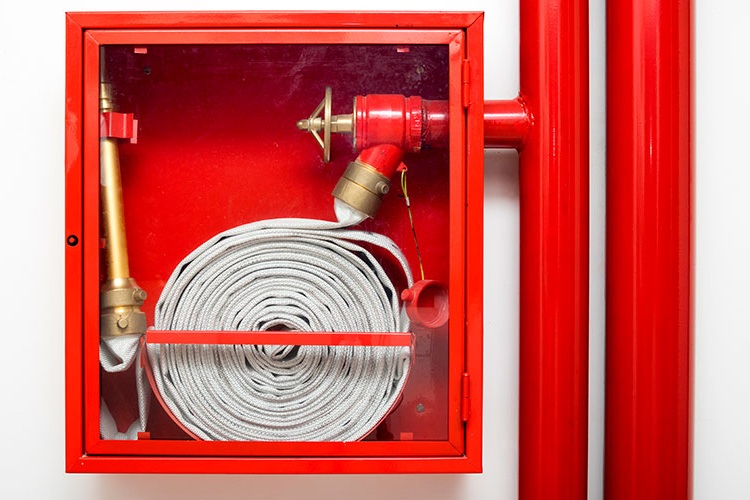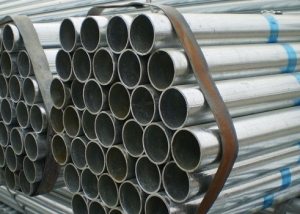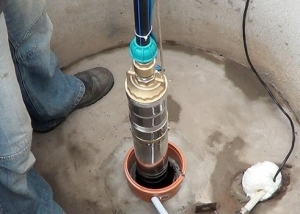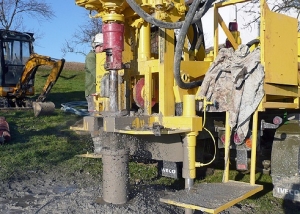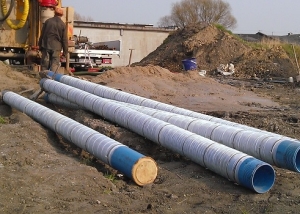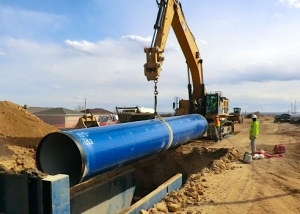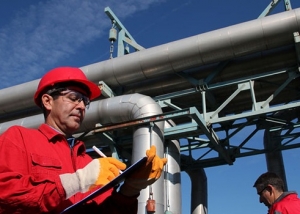Internal fire water supply (ERW) is a complex system for ensuring fire safety inside public buildings. This is an autonomous pipeline, which is provided with various technical equipment. The work scheme often involves the interaction of internal and external fire water supply.
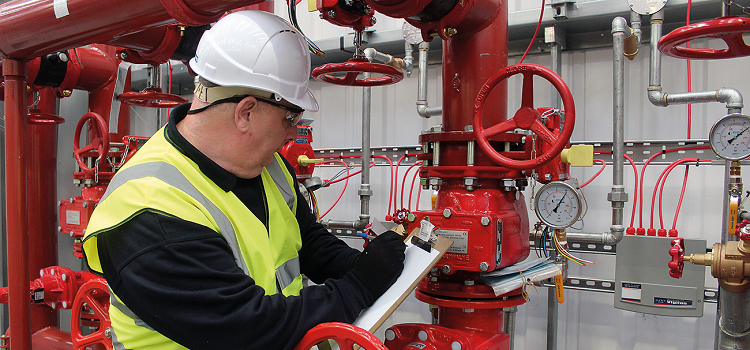
Fire systems inside buildings - a necessary safety measure, which must comply with all requirements of SNiP
Content
- 1 The purpose of the internal system of ERW
- 2 Where internal fire water supply is needed
- 3 Standards for water consumption at various facilities
- 4 Automatic fire control
- 5 Requirements for a complete set of internal fire water supply
- 6 The use of polypropylene pipes in fire systems
- 7 Technical requirements for ERW
- 8 The method of determining the pressure in the pipes
- 9 Checking and testing the fire system
The purpose of the internal system of ERW
A fire water supply system inside buildings is needed as an alternative fire fighting scheme. With its help, it is easy to stop the spread of flame when ignited. Autonomous water supply for extinguishing fires is the provision of water supply to fire hydrants with pressure under sufficient pressure. In the event of an emergency, the internal water supply intended for fire fighting is indispensable until the arrival of fire brigades, whatever the location of the flame.
Fire water pipelines are effective for eliminating small fires in the first stage, when there is no smoke in the premises. This system can be used by employees of enterprises who have been instructed and know how to remove the sealing of the system and connect to the pump station. This information should be reported to:
- voluntary fire brigades (DPD);
- technical personnel of institutions and enterprises;
- Responsible for fire safety workers of buildings of different functionalities.
The use of fire water supply is possible when it is consistent with safety regulations. When starting and operating an internal fire extinguishing system, those who work in a shopping and office center or industrial enterprise, as well as all those living in a hostel (another building), should not be exposed to risk.
Regarding the functionality and the basic application scheme, integrated fire extinguishing systems are divided into two types:
- multifunctional water supply for general water supply;
- special fire water supply.
The first scheme works like a normal household water supply, but at the same time it is able to provide water for the fire protection scheme. When designing it, the possibility of connecting with the general water supply of the entire building or its individual buildings is laid.
Fire conduit is designed exclusively for the localization of fires. Water supply under high pressure is transmitted through a separate riser of multi-storey buildings.
According to the type of scheme, the fire water supply inside the rear is distinguished as:
- dead end (end);
- ring (universal).
The second type is characterized by the presence of locking devices capable of cutting off damaged areas from the general circuit. In this case, the water supply will continue to work in an emergency.A deadlock scheme is used with a small number of trailer fire hydrants - up to 12 units for the entire building.
Where internal fire water supply is needed
According to fire safety (BP), ERW must be planned when designing objects of various types:
- dormitories (different storeys);
- residential apartment buildings and residential complexes (more than 12 floors);
- warehouses, industrial and industrial buildings;
- administrative and management buildings (more than 6 floors);
- crowded places of citizens (theaters and cinemas, clubs and discos, sports arenas and assembly halls).
The installation of this fire extinguishing system is not provided for in small buildings of buildings with such functionality as:
- summer cinemas and outdoor stadiums;
- secondary schools (except for boarding schools with permanent residence of pupils);
- agricultural warehouses (including mineral fertilizers);
- hangars and buildings for industrial production 1-3 categories of fire resistance;
- a workshop for a specific purpose (where water is capable of producing a chemical reaction that provokes an explosion, gas contamination, smoke or fire);
- hangar warehouses and workshops where there is the possibility of fire fighting from nearby reservoirs or reservoirs.
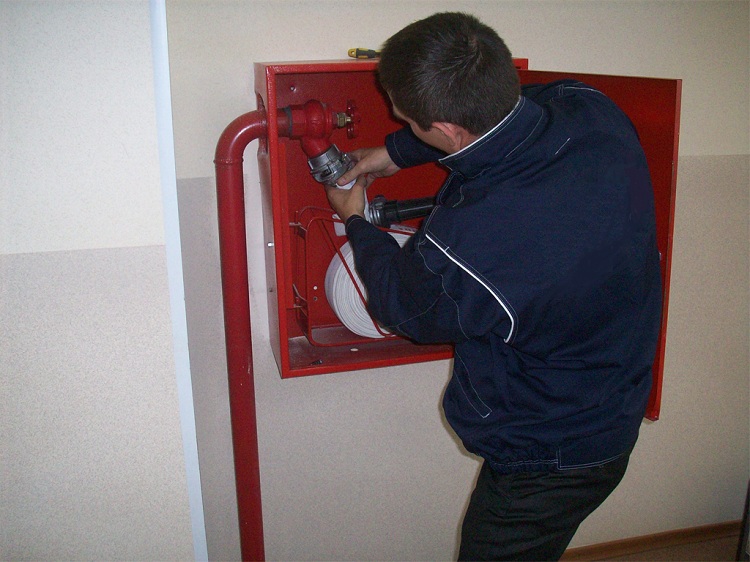
Residential and industrial buildings of various types should be equipped with fire-fighting systems.
Note! On the basis of one of the points of the Code of Rules on “Residential multi-apartment buildings”, each apartment should provide convenient access to a separate crane with a diameter of about 15 mm. At this point, firefighters can attach a fire hose with a spray gun.
This measure is necessary for urgent fire fighting in the apartment and on the landing, if there is no other way to extinguish the primary fire. Also, in each apartment there should be a hose of sufficient length to ensure the supply of water to the most remote corners of the premises.
A red box with a fire fighting sleeve should be placed in a prominent place in most administrative buildings, in trade and office, educational and medical buildings, in workshops and residential buildings with large floors.
Standards for water consumption at various facilities
Requirements for the need for ERW are indicated in the relevant requirements. According to fire regulations, the number of trunks to extinguish a fire with a minimum water consumption for fire extinguishing is proportional to the number of storeys, the capacity of the ERW and the square of the building. The norms for water consumption in residential warehouses and public buildings, as well as on administrative and household units at industrial facilities of the 1st and 2nd degree of fire resistance should include tanks:
- 2x2.5 l / s - for buildings A, B, C of category with a volume of 0.5 thousand cubic meters up to 5 thousand cubic meters;
- 2x5 l / s. (same parameters) up to 200 thousand cubic meters;
- 3x5 l / s. (the same parameters) up to 400 thousand cubic meters;
- 4x5 l / s. (same parameters) up to 800 thousand cubic meters
- for category B buildings with a volume of up to 5 thousand cubic meters 3rd, 4th and 5th degree of fire resistance and with a volume of up to 5 thousand cubic meters - 2x2.5 l / s.
- for buildings of category G and D, the 3rd level of fire resistance, up to 200 thousand cubic meters - 2x2.5 l / s.
These parameters relate to the joint venture for external and internal fire water pipelines, including:
- already existing;
- reconstructible;
- designed.
Automatic fire control
System monitoring of the uninterrupted operation of this network is carried out through a remote control panel or in separate units with sensors. Highly sensitive equipment in automatic mode independently copes with many functions:
- Alert by sound (light) signal about the occurrence of a fire in one or another part of the building.
- Monitoring the water level in the tank or tank.
- Starting additional pumps at low pressure.
- Automatic locking of valves.
ERW also includes monitoring and control units, pumping stations for increasing working pressure and water tanks. An established fire-fighting fire extinguishing scheme is a guarantee of the effective elimination of fire in any part of the building and its localization prior to the arrival of the Ministry of Emergencies. The internal fire water supply system is designed and operates in accordance with certain standards fixed in the relevant documentation.
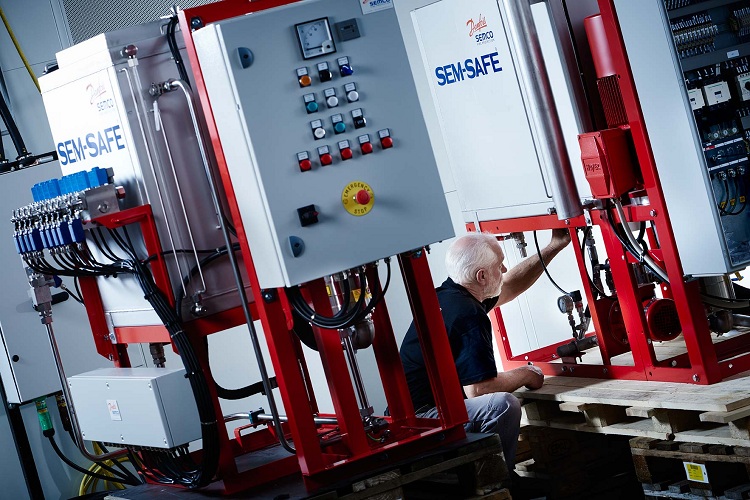
The fire water supply system is equipped with a monitoring and control system, and some actions are performed automatically using electronic sensors
Requirements for a complete set of internal fire water supply
The internal water supply system for fire extinguishing should have the following equipment:
1. In working condition, control and locking equipment. An external fire water supply and a common water supply or other water supply source must be connected to the ERW. The system will be effective provided that there is sufficient pressure to provide a fairly powerful jet with fine dispersion at the fire extinguishing outlet. In this case, the maximum water flow rate for extinguishing any type of fire is preferable.
Be sure to connect to any type of water supply system, in which there is always water:
- technical;
- industrial;
- economic;
- plumbing with drinking water.
2. There is a station with a control point of the ERW and a fire pump, which will provide good pressure at low pressure in an external source or water supply. The pump and control point should be located below:
- 1st floor;
- basement;
- ground floor;
- semi-basement.
This room can be bordered by a boiler room, boiler room or water distribution point, as well as located separately.
3. Mandatory access to the station (console) with a button to start and block the operation of the fire pump. Nearby should be a blocker (gate valve) of the ERW circuit and automatic control of the fire alarm system of the building in working condition. A scheme combining automation and manual control to adjust the connection and filling of the fire water with water is possible - for reliable start-up.
4. A separate fire tank for storing the necessary supply of water in case of lack of it in the water supply. A minimum supply of water is necessary to start the pump and to localize the fire before the arrival of specialists. These are the so-called hydropneumatic or water tanks.
Attention! The absence of a reserve tank is permissible if there is a guarantee of constant filling of the water supply system and with the automatic start of the fire pump.
5. A hand-operated fire barrel (connection to a fire fighting sleeve), which must be placed in lockable niches or in closed boxes with sealing. Placement - in a place accessible for visual inspection.
6. The presence of internal PCs in the lobby, at the entrance, on the rise near the stairwell, in the lobby on the aisles and corridors. The launch and use of the fire hose must be in any place accessible to the public. The length of the sleeve or hose is calculated so that the water reaches any point of possible ignition. PCs are placed at eye level. Twin taps can be near, above or below.
7. Pre-engineered risers and ERW networks (vertical and horizontal). The scheme should be organized on the basis of the layout of the building so that the placement of the fire water supply system is optimal. Construction with a height of more than 6 floors implies the presence of vertical fire risers connected to a common water supply from steel pipes.
Attention! A separate ERW of any construction is created from metal pipes.It is supposed to use polymer pipes on separate parts of the circuit, but they must have a fire safety certificate.
The requirements for ERW are regulated by state legislation and national standardization (GOST):
- Federal Law "On Fire Safety".
- JV “Fire protection systems. ERW, fire safety requirements ”(main document).
- JV “Public buildings and structures”.
- GOST "Fire Engineering. SHG. General technical requirements (OTT). Test Methods. "
- JV “Residential multi-apartment buildings.
- GOST "Fire Engineering. Pressure head fire hoses. OTT. Test Methods. "
- GOST "Fire Engineering. Cabinets are fire. OTT. Test Methods. "
- GOST “Signal colors, safety signs and signal marking. Purpose and rules of use. OTT and characteristics. Test Methods. "
- "The rules of the fire regime in the Russian Federation."
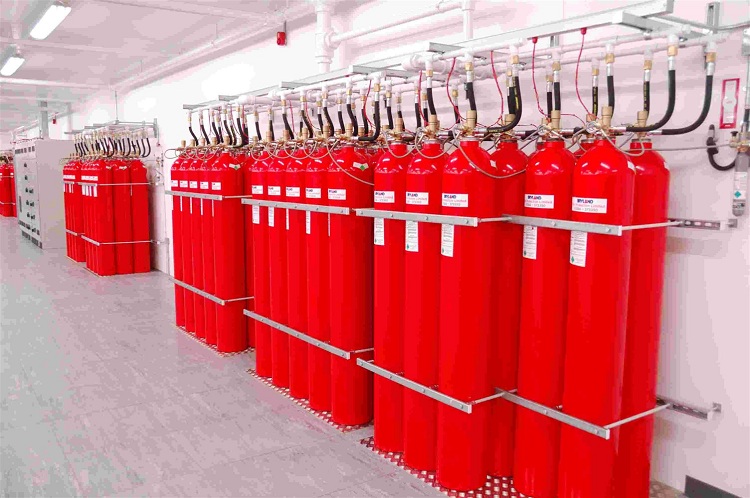
At industrial enterprises, the fire extinguishing system can be supplemented with cylinders with chemicals that are used to extinguish flammable substances
Departmental rules and industry standards for the organization of ERW should be in place. They describe the specifics and functionality of enterprises, the main indicators of the physicochemical properties of equipment and materials involved in the production process. For example, it is impossible to extinguish with water those substances that enter into a chemical reaction with excessive heat. Flammable liquids are extinguished with a special foam, not water, so as not to expand the area of the fire.
The use of polypropylene pipes in fire systems
In case of inaccessible installation during the repair of the fire extinguishing system, an alternative is used - polymer pipes made of PP. There are domestic pipes and imported, but in the end, their installation is more economical than metal and welding. Certified products are a guarantee of quality, and labeling or instructions for use issued upon purchase confirm their ability to be used in ERW. Products have successfully passed multilevel tests and confirmed compliance with all standards.
Polypropylene pipes used in fire extinguishing systems have undeniable advantages:
- resistance to condensate;
- wear resistance;
- not clogged with rust;
- have easier installation using diffusion welding and fittings;
- less specific gravity and reduced load on the structure (important for installation on the upper floors and in outbuildings);
- do not ignite;
- have increased throughput due to a clean smooth surface inside and the absence of rough seams.
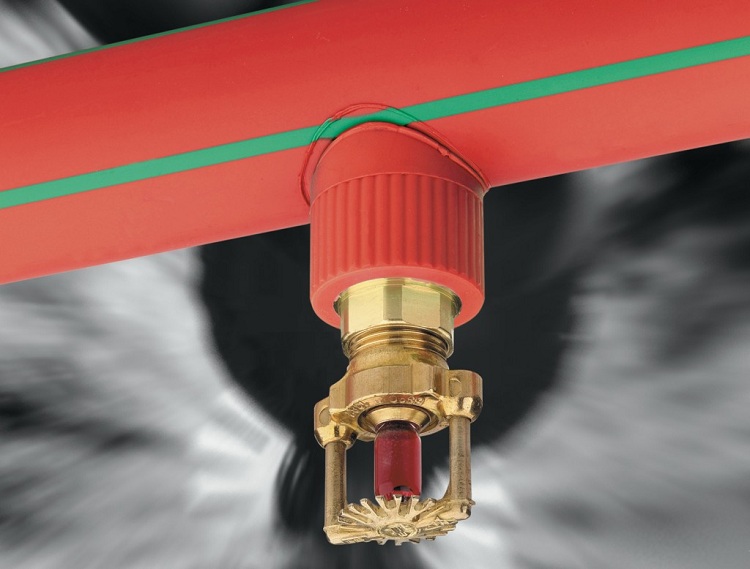
Special polypropylene pipes have many advantages over steel pipes when used in fire fighting systems
Attention! In those facilities where it is unacceptable to carry out repairs, installation and dismantling using welding, specialized FIREPROFF systems connected by couplings and fittings are recommended. Such a fire extinguishing pipe can be combined with a common water supply, where drinking water is connected.
Specialized polymer pipes are protected against ignition by a refractory layer. Installation with fittings ensures a solid fit with the metal part of the system and with each other. Due to the absence of welded joints in the system, leaks are excluded. The lack of need for a welding machine makes it possible to dock pipes at industrial facilities during working hours - without stopping production.
Compatibility with a utility pipeline for drinking water supply and fire extinguishing systems from polyurethane foam pipes is confirmed by resistance to a number of processes. They do not form:
- scale (calcium precipitate);
- rust;
- chemical and biological sediment (siltation).
Components and pipes of polymer systems of the FIREPROFF type are offered in different colors, so they are selected for the general finish in open areas.Light weight makes it easy to transport. The joining method is easy to master and apply at different sites, and certification and tolerance are not needed, as in the organization of welding in the traditional way.
Technical requirements for ERW
The main condition for ERW systems in a building of any type is the complete working condition. Location in public areas is a guarantee that any fire will be quickly localized.
Attention! When replacing fire extinguishing system pipes (other types of repair work), it is important to provide an alternative fire safety!
The design of the ERW design should be based on the general requirements of SNiP and safety standards (fire safety), taking into account the number of barrels and cranes on all floors:
- One for a residential building up to 16 floors and two for a long length of corridors.
- Two ERW barrels in residential buildings up to 25 floors. Plus one more with corridors longer than 10m.
The flow rate of water for each fire barrel is from 2.5 l / s. With a smaller cross section of the fire hose and pipes for water supply (38 mm), the flow rate is from 1.5 l / s. If the risers of the fire water supply are powered with a common main water supply of the building, they are recommended to be made of galvanized steel or polypropylene.
Advice! Sometimes you need to reduce the pressure on the lower floors in the fire barrels. Then the pipeline is equipped with diaphragms with a common hole diameter for all.
The method of determining the pressure in the pipes
Designed water loss is necessary for the effective operation of ERW systems. Calculations are made according to a special program or according to the formula. This helps to calculate the pressure during water loss. For more accurate calculations, it is better to take the parameters for the remote ERW barrel, then the pressure formula will be calculated with small errors.
Н = Нвг + Нп + НПП + Нпк
Indicated here:
- the required level of water loss - NPC;
- the height of the water supply from the city network to the fire barrel - NVG;
- estimated pressure loss in the riser pipe - Np;
- pressure loss in the riser in fire fighting mode - NPP.
Attention! The design of such a system as an internal fire water supply system and accurate calculations of the pressure in the system is best left to a specialist who will conduct them on the basis of SNiP. The coordination and approval of the completed project must be endorsed by the fire department.
The fire water supply project involves compliance with the following technical parameters:
- diameter of the fire riser - from 65 mm;
- marginal pressure of the lower barrel - 0.9 MPa;
- diameter of the fire hydrant - 50 mm (design load up to 2.5 l / s) or 65 mm (load over 4 l / s);
- the diameters of the connected trunks with the riser of the ERW pipes - from 50 mm;
- fire hydrant 50 mm and 65 mm.
The presence of shutoff valves is a prerequisite on the upper and lower floors of the fire column. It is assumed on the ring network (in wiring) and on all branches by floors. If there is insufficient water pressure in the VPW system, it is necessary to supply it with a pump. This will ensure the supply of the required volume to each floor of the building (in the utility block on the lower floor).
The remote (automatic) start signal goes to the pumping station after checking the water pressure in the entire system. With good pressure, the pump starts to cancel until the pressure drops, since the pump starts. After checking the pressure in the system, the start of the pumps is canceled (does not exclude the opening of the bypass gate valve). The control system assumes a pump start delay circuit for as long as the bypass valves open. A few seconds are enough for this, and it automatically switches to the open position.The project of multifunctional air-conditioning systems - the possibility of combining with a utility pipeline and a water supply for drinking water when operating in automatic mode.
Checking and testing the fire system
The effectiveness of the fire system should be checked periodically without waiting for an emergency. A performance check is tested or tested on the most important parameters. This is necessary to identify the level of return of the pipeline, the pressure in the network and check the pumps. The implementation of the preventive check should be entrusted to the specialists of the enterprise, who have permission. Verification includes:
- testing of water supply and system pressure;
- checking the valve shutter mechanisms.
Existing in the structure of the ERW is periodically checked for several parameters with a test of its performance. The maintenance standards of the system are set forth in the “Test Methodology for Internal Fire-Fighting Water Pipeline” (published for the Ministry of Emergencies of the Russian Federation in 2005). According to this document, the maintenance of an internal fire water supply system involves a check once every six months:
- operability of PB cranes;
- pressure in the water supply;
- shutoff valves;
- coverage area with a water stream;
- complete set of each fire cabinet.
Also, a fire hose should be tested annually in terms of resistance to water pressure and its rolling. The performance of the pumps is checked monthly. The main tests of the pressure level regulated by the pump should be carried out on a remote barrel. After the test, reporting is made:
- a statement of deficiencies in the safety management system;
- protocol on the operability of cranes;
- comprehensive inspection report;
- maintenance behavior report.
The level of water loss is checked by means of measuring instruments inside the system, including pressure gauges on coupling heads. Testing the level of water loss is carried out according to the following scheme:
- Open the PB cabinet and disconnect the fire hose.
- In the presence of a barrel diaphragm reducing pressure, its diameter is checked with a caliper and verified with the indicated parameters.
- An insert with a pressure gauge is attached to the fire hydrant.
- The fire hose is connected in the system, and its nozzle is directed into water tanks. One worker holds a sleeve, the other connects water.
- The fire detector switches on, the valve opens and the pump starts.
- The pressure of the water is reflected on the pressure gauge, the working data is removed after 20-40 seconds from the start-up time, when the pressure is stabilized.
- After the test, the pump is turned off, the valve of the valve is shut off, the data is recorded in the test log to further draw up an act. The measuring equipment is removed, the sleeve and all components are returned to their original position.
The documentation (workbook, inspection report, etc.) is certified by the members of the commission. The operation of the air-blast can be considered effective when the entire system and individual equipment units are in good condition. The full use of fire extinguishing equipment largely depends on the knowledge and qualifications of the personnel responsible for its work. Practical training courses are periodically conducted for them (on the introduction of new methods of operation, prevention and maintenance of the building’s fire system).
